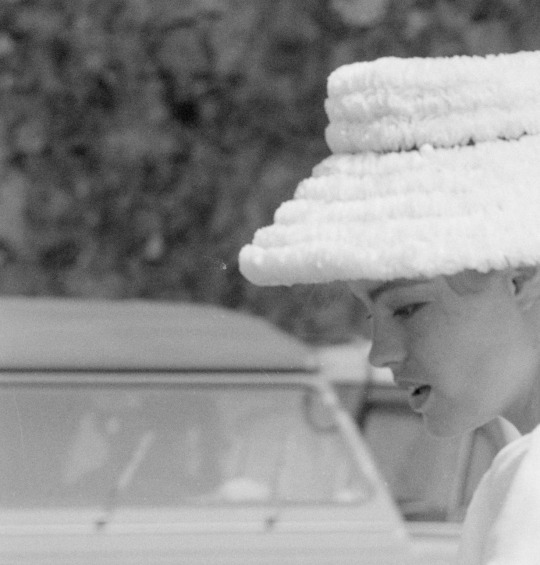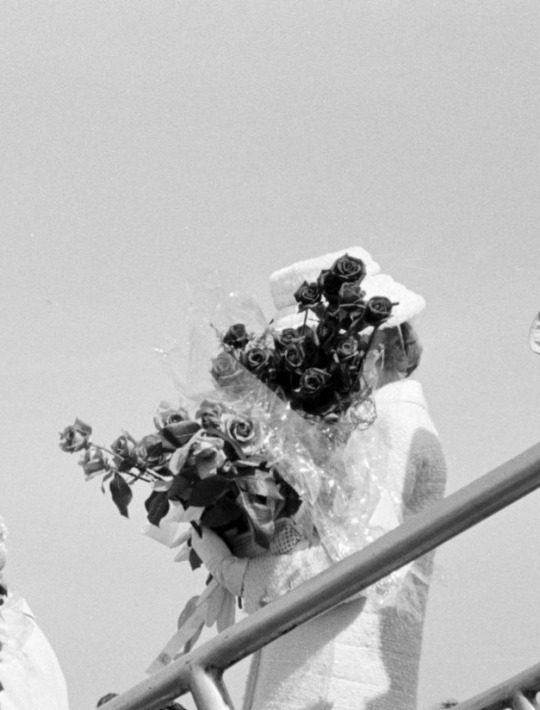#bocaccio 70
Explore tagged Tumblr posts
Text

Beautiful María Montez II photo published in Spanish magazine "Bocaccio 70" in 1971.
🌟Very special thanks to Andrea Montez who found this great pic in todocoleccion.net🌟
#María Montez II#Maria Montez II#María Montez Gracia Fiallo#Maria Montez Gracia Fiallo#actress#model#dancer#1971 Bocaccio 70#Bocaccio 70#collaboration#Montez Family#1971 María M
8 notes
·
View notes
Text
Epic Fantasy through the Ages
A Chronology of Story
This is a work in progress, but here is my list as of 6 July 2023. Please feel free to send me additions or corrections. I have focused on epic (works that are long and took a long time to create) and fantasy (works that include an element of magic, the supernatural, or superpowers). Some of the list could be categorized as myth, some as Literature™️, some as science fiction, but beyond these categories are the two main criteria of epic and fantasy. I also don't fully know what all of the ancient to modern works encompass, but that's the fun of read and find out. I probably have added some things that don't properly meet my criteria, and that's fine with me. 🌺
Works by Mesopotamian Bards (3100 BC - 539 BC)
Enumah Elish (Epic of Creation)
Atrahasis (The Flood)
Epic of Gilgamesh
Descent of Ishtar
Epic of Erra
Etana
Adapa
Anzu
Nergel and Ereshkigal
Avesta by Zoroastrian Bards (1500 BC)
Ramayana by Valmiki (750+ BC)
Mahabharata by Vayasa (750+ BC)
The Illiad and the Odyssey by Homer (650+ BC)
Thoegeny; Works and Days by Hesiod (650+ BC)
Popol Vuh (4th century BC)
The Torah and other Jewish stories (4th century BC)
Argonautica by Apollonius of Rhodes (270 BC)
Bellum Punicam by Gnaeus Naevius (200 BC)
Annales by Ennius (170 BC)
De Rerum Natura by Lucretius (50 BC)
Poem 64 by Catullus (50 BC)
The Aenid by Virgil (19 BC)
Metamorphoses by Ovid (2 AD)
Punica by Silius Italicus (50 AD)
Satyrica by Petronius (60 AD)
Pharsalia or Bellum Civile by Lucan (62 AD)
Argonautica by Valerius Flaccus (70 AD)
Thebaid by Statius (90 AD)
The Irish Myth Cycles: Mythological, Ulster, Fenian, and Kings (3rd Century AD)
The Bible and other Christian stories (5th century AD)
Dionysiaca by Nonnus of Panopolis (500 AD)
The Quran and other Muslim stories (7th century AD)
Arabian Nights (7th century AD)
Hildebrandslied and other German heroic lays by Bards (830 AD)
Shahnameh by Ferdowsi (977 or 1010 AD)
Chanson de Roland (1125 AD)
Cantar de Mio Sid (1200 AD)
The Dietrich Cycle (1230 AD)
Poetic Edda and Prose Edda by Snorri Sturluson and others (1270 AD)
Beowulf by Old English Bards (11th century AD)
Nibelungenlied by Middle High German Bards (1200)
Amadís de Gaula (13th century AD)
The Divine Comedy by Dante Alghieri (1308)
Teseida by Bocaccio (1340 AD)
Sir Gawain and the Green Knight by Middle English Bards (14th century)
The Canterbury Tales by Geoffrey Chaucer (1392)
Morgante by Luigi Pulci (1483)
Le morte d'Arthur by Thomas Mallory (1485)
Orlando Innamorato by Boiardo (1495)
Orlando Furioso by Ariosto (1516)
Os Lusiadas by Camoes (1572)
Gerusalemme Liberata by Tasso (1581)
Plays and Poems by William Shakespeare (1589)
The Faerie Queen by Edmund Spencer (1590)
Discourses on the Heroic Poem by Tasso (1594)
Don Quixote by Miguel de Cervantes (1614)
L'Adone by Marino (1623)
Paradise Lost; Paradise Regained by Milton (1667)
Le Lutrin by Boileau (1674)
Order and Disorder by Lucy Hutchinson (1679)
Mac Flecknoe; Aenid English translation by Dryden (1682)
The Dispensary bu Samuel Garth (1699)
The Battle of the Books; A Tale of a Tub by Swift (1704)
The Rape of the Lock; Illiad and Odyssey English translations; Dunciad by Pope (1714)
The Vanity of Human Wishes by Samuel Johnson (1749)
Scribleriad by Richard Owen Cambridge (1751)
Faust by Goethe (1772)
The Triumphs of Temper; Essay on Epic Poetry by William Hayley (1782)
The Task by William Cowper (1785)
Joan of Arc; Thalaba the Destroyer; Madoc; The Curse of Kehama by Southey (1796)
The Prelude; The Execution by Wordsworth (1799)
Jerusalem by Blake (1804)
The Rime of the Ancient Mariner by Coleridge (1817)
Laon and Cythna; Peter Bell the Third; Prometheus Unbound by Shelley (1817)
Hyperion: A Fragment; The Fall of Hyperion by Keats (1818)
Don Juan by Byron (1819)
The Kalevala by Elias Lonnrot (1835)
Sohrah and Rustum by Matthew Arnold (1853)
Hiawatha by Longfellow (1855)
Leaves of Grass by Walt Whitman (1855)
Idylls of the King by Lord Alfred Tennyson (1859)
Cantos by Ezra Pound (1917)
The Wasteland by T.S. Eliot (1922)
Ulysses by James Joyce (1922)
The Hobbit/The Lord of the Rings/The Silmarillion etc. by J.R.R. Tolkien (1937)
Gormenghast by Mervyn Peake (1946)
The White Goddess by Robert Graves (1948)
Hero with a Thousand Faces by Joseph Campbell (1949)
The Chronicles of Narnia by C.S. Lewis (1950)
Anathemata by David Jones (1952)
Dune by Frank Herbert (1965)
The Dark Is Rising Sequence by Susan Cooper (1965)
Briggflatts by Basil Bunting (1965)
Earthsea by Ursula K. LeGuin (1968)
Dragonriders of Pern by Anne McCaffrey (1968)
The Chronicles of Amber by Roger Zelazny (1970)
The Vampire Chronicles by Anne Rice (1976)
The Chronicles of Thomas Covenant by Stephen Donaldson (1977)
The Magic of Xanth by Piers Anthony (1977)
Book of the New Sun by Gene Wolf (1980)
The Dark Tower by Stephen King (1982)
Belgariad and Mellorean by David Eddings (1982)
The Mists of Avalon by Marion Zimmer Bradley (1982)
Shannara by Terry Brooks (1982)
The Riftwar Cycle by Raymond E. Feist (1982)
Discworld by Terry Pratchett (1983)
Mythago Wood by Robert Holdstock (1984)
Neuromancer by William Gibson (1984)
The Black Company (1984)
Redwall by Brian Jaques (1986)
Valdemar by Mercedes Lackey (1987)
Memory, Sorrow, Thorn by Tad Williams (1988)
Sandman by Neil Gaimon (1989)
The Wheel of Time by Robert Jordan (1990)
Queen of Angels by Greg Bear (1990)
Newford by Charles de Lint (1990)
Omeros by Derek Walcott (1990)
The Saga of Recluse by L.E. Modesitt, Jr. (1991)
The Witcher by Andrzej Sapkowski (1993)
Sword of Truth by Terry Goodkind (1994)
Realm of the Elderlings by Robin Hobb (1995)
His Dark Materials by Philip Pullman (1995)
Old Kingdom by Garth Nix (1995)
A Song of Ice and Fire/Game of Thrones by George R.R. Martin (1996)
Animorphs by H.A. Applegate (1996)
Crown of Stars by Kate Elliott (1997)
Harry Potter by J.K. Rowling (1997)
The Malazan Book of the Fallen by Steve Erickson (1999)
The Dresden Files by Jim Butcher (2000)
The Inheritance Cycle by Christopher Paolini (2002)
Prince of Nothing by R. Scott Bakker (2003)
Bartimaeus by Jonathan Stroud (2003)
The Gentlemen Bastard Sequence by Scott Lynch (2004)
Twilight by Stephanie Meyer (2005)
Percy Jackson and the Olympians by Rick Riordan (2005)
Temeraire by Naomi Novik (2006)
The First Law by Joe Abercrombie (2006)
Mistborn by Brandon Sanderson (2006)
The Kingkiller Chronicle by Patrick Rothfuss (2007)
Shadows of the Apt by Adrian Tchaikovsky (2008)
The Hunger Games by Suzanne Collins (2008)
Graceling by Kristin Cashore (2008)
Riyria Revelations by Michael J. Sullivan (2008)
Night Angel by Brent Weeks (2008)
The Demon Cycle by Peter V. Brett (2008)
Inheritance by N.K. Jemisin (2010)
The Lightbringer by Brent Weeks (2010)
The Stormlight Archive by Brandon Sanderson (2010)
The Expanse by James S.A. Corey (2011)
The Broken Empire by Mark Lawrence (2011)
The Lunar Chronicles by Marissa Meyer (2012)
Throne of Glass by Sarah J. Maas (2012)
Grishaverse by Leigh Bardugo (2012)
The Traitor Son Cycle by Miles Cameron (2012)
Worm by Wildbow (2013)
The Powder Mage by Brian McClellan (2013)
The Broken Earth by N.K. Jemisin (2015)
Shards of Heaven by Michael Livingston (2015)
The Green Bone Saga by Fonda Lee (2017)
The Band Series by Nicholas Eames (2017)
Winternight by Katherine Arden (2017)
The Folk of the Air by Holly Black (2018)
The Founders by Robert Jackson Bennett (2018)
The Locked Tomb by Tamsyn Muir (2019)
Grave of Empires by Sam Sykes (2019)
Djeliya by Juni Ba (2021)
10 notes
·
View notes
Text

Romy Schneider Cannes Film Festival. 1962 - François Gragnon
#romy schneider#1960s#francois gragnon#vintage chanel#bocaccio 70#luchino visconti#vintage fashion#cinema#old hollywood#vintage hollywood#films
73 notes
·
View notes
Photo






Grandes películas antológicas de Italia, Francia e Inglaterra. De arriba a abajo:
Histoires extraordinaires (1968), inspirada relatos de Edgar Allan Poe y dirigida por Roger Vadim, Louis Malle y Federico Fellini.
I tre volti della paura (Black Sabbath, 1963), dirigida por Mario Bava y protagonizada por Boris Karloff.
Bocaccio 70 (1962), con historias dirigidas por Mario Monicelli, Federico Fellini, Luchino Visconti y Vittorio de Sica.
Dr. Terror's House of Horrors (1965), con Peter Cushing y Christopher Lee. Dirigida por Freddie Francis. Trato de verla todos los años.
Dead of Night (1945), dirigida por Alberto Cavalcanti, Charles Crichton, Basil Dearden y Robert Hamer.
Asylum (1972), escrita por Robert Bloch y dirigida por Roy Ward Baker. Su elenco es formidable.
#Histoires extraordinaires#Anthology Films#movies#I tre volti della paura#Bocaccio 70#posters#Dr. Terror's House of Horrors#Amicus#Dead of Night#Asylum
2 notes
·
View notes
Text

Sophia Loren behind the scenes of the film ‘Boccaccio ‘70’, circa 1962.
113 notes
·
View notes
Photo

66 notes
·
View notes
Text
Biologists in general, and the people who study platform wildlife in particular, often argue over whether a specific habitat feature (in this case an oil platform) actually increases the population of a species or whether it simply acts as a meeting place for creatures that would otherwise gather somewhere else.
Love began to think of ways to investigate whether platforms were aggregating or actually producing more fish. “When you see 150,000 baby bocaccio rockfish at a platform, it looks like a good nursery ground. But if you pull out the platform, would the drifting larvae find another reef to shelter in?”
If yes, then the platform would be superfluous as far as the rockfish are concerned.
Love and his team began looking at ocean currents. A collaborator created a computer model that could reflect prevailing weather patterns and added in the drifting bocaccio larvae. A lot of them hit the platform. Then Love’s team removed the platform from the model and watched the rockfish drift again. They assumed that bocaccio carried inshore would find their usual nursery sites and survive, while those that drifted out to sea—where there are few natural surfaces to provide shelter and food—would die. Over a three-year period, Love’s team concluded that 70 percent of the juveniles would die if the platform were removed.
“This doesn’t mean it’s true for all platforms, all species,” he cautions. “But it lends credence that maybe these platforms are pretty good nursery grounds. And if that’s true, then it’s very hard to argue that platforms are not helping to produce fish.”
— Oil Rigs Are a Refuge in a Dying Sea
#oil rigs are a refuge in a dying sea#sasha chapman#milton love#science#marine biology#marine life#animals#environmentalism#ecology#novel ecosystems#wildlife conservation#fish#rockfish#bocaccio rockfish#reefs#artificial reefs#oil platforms
7 notes
·
View notes
Photo






COPA DE CRISTAL DE LA DISCOTECA BOCACCIO DE BARCELONA
CON EL LOGO TÍPICO DE LA DISCOTECA DE LA CALLE MUNTANER DE BARCELONA REGENTADA POR ORIOL REGÀS, QUE SE CONVIRTIÓ EN EL TEMPLO DE LA MODERNIDAD, LA INTELECTUALIDAD Y LA "GAUCHE DIVINE" DE LA CIUDAD EN LOS AÑOS 60/70
MEDIDAS:
ALTO 19 cms, DIÁMETRO BOCA 10 cms. DIÁMETRO BASE 9 cms.
PESO:342 grs
DISPONGO DE OTRA IDÉNTICA, PERSONALIZADA CON GRABADO AL ACIDO DEL CLINTE VIP (JOSÉ FERRER) HAGO UN SUSTANCIAL DESCUENTO POR LA COMPRA DE LAS DOS
90 € MÁS GASTOS DE ENVÍO
0 notes
Photo

(via Movie Poster - Boccaccio '70, Karel Teissig, 1963)
Bocaccio ’70 movie poster.
title: Boccaccio ’70 | Italy, 1962
director: Vittorio De Sica, Federico Fellini, Mario Monicelli, Luchino Visconti
with: Anita Ekberg, Sophia Loren, Romy Schneider
poster designer: Karel Teissig, Czechoslovakia, 1963
For poster shop and blog highlights please subscribe to our daily or weekly newsletter: http://eepurl.com/RvXo9 (25% OFF for Students)
#movie poster#Federico Fellini#Sophia Loren#Anita Ekberg#Luchino Visconti#Romy Schneider#Vittorio De Sica#Mario Monicelli#collage#graphic design#Karel Teissig#made in Czechoslovakia
25 notes
·
View notes
Text



Romy Schneider. Cannes film festival. 1962. by Jean-Pierre Biot
#romy schneider#1960s#jean-pierre biot#60s#vintage chanel#coco chanel#luchino visconti#bocaccio 70#vintage hollywood#old hollywood#vintage fashion#film
43 notes
·
View notes
Text
CCBB recebe retrospectiva completa do cineasta Federico Fellini
Que tal rever toda a obra do mestre italiano Federico Fellini? Essa oportunidade é sua, jovem, com a mostra em homenagem aos 100 anos de nascimento do cineasta que rola no CCBB São Paulo.
Intitulada de “Fellini, Il Maestro“, a retrospectiva é uma oportunidade única de assistir, na sala de cinema, vários clássicos do cinema mundial, de mergulhar no mundo felliniano, com suas histórias e personagens fascinantes.
Ao todo, são apresentados 24 títulos, desde o filme de estreia de Fellini, “Mulheres e Luzes” (1950), codirigido com Alberto Lattuada, até o último deles, “A Voz da Lua” (1990), incluindo obras-primas estreladas por parceiros constantes como Marcello Mastroianni e Giulietta Masina, sua esposa, e embaladas pela música de Nino Rota.
A mostra também exibe no CCBB o documentário “Fellini: A Director’s Notebook” (1969), no qual o próprio Fellini comenta seu processo de trabalho e passeia por seus lugares preferidos em Roma.
QUE TAL UM CINEMINHA A R$ 8 NAS POLTRONAS DA CINESALA?
Todas as sessões têm entrada gratuita e acontecem de 26 de fevereiro a 23 de março, de quarta a segunda-feira, entre 9h e 21h – os horários você confere abaixo.
E tem mais! A programação do CCBB São Paulo ainda oferece outras atividades gratuitas, com foco na obra de Fellini, como o debate, no dia 12 de março, com a presença dos críticos Neusa Barbosa e Felipe Furtado.
Nos dias 16, 18 e 19 de março, você pode aproveitar um curso ministrado por Felipe Furtado. As inscrições para o curso devem ser feitas pelo e-mail [email protected].
Quem foi Federico Fellini?
Federico Fellini é reconhecido como um dos maiores e mais influentes cineastas de todos os tempos, cujos filmes, que trazem um olhar altamente pessoal e idiossincrático sobre a sociedade, são uma combinação única de memória, sonhos, fantasia e desejo.
O adjetivo felliniano é sinônimo de qualquer tipo de imagem extravagante, barroca ou fantasiosa no cinema ou na arte em geral. “A Doce Vida” lançou um novo termo: paparazzi, derivado de Paparazzo, o fotógrafo amigo do jornalista Marcello Rubini, vivido por Mastroianni.
Fellini morreu em Roma, em 31 de outubro de 1993, ao 73 anos, de ataque cardíaco, um dia depois da celebração dos 50 anos de casamento com Giulietta Masina. O funeral, no Estúdio 5 da Cinecittà, seu favorito, atraiu 70 mil pessoas.
Programação de ‘Fellini, Il Maestro’ no CCBB:
26/02 – Quarta 17h Mulheres e Luzes 19h30 Ensaio de Orquestra
27/02 – Quinta 16h A Cidade das Mulheres 19h Os Boas Vidas
28/02 – Sexta 16h Casanova de Fellini 19h30 Os Palhaços
29/02 – Sábado 16h Ensaio de Orquestra 18h30 Amarcord
1º/03 – Domingo 15h30 Noites de Cabíria 18h Oito e Meio
2/03 – Segunda 15h Bocaccio 70 19h30 Os Palhaços
4/03 – Quarta 17h A Director`s Notebook 18h30 Satyricon de Fellini
5/03 – Quinta 16h Histórias Extraordinárias 19h Roma
6/03 – Sexta 16h30 Mulheres e Luzes 19h Amarcord
7/03 – Sábado 15h30 A Cidade das Mulheres 18h30 Ginger e Fred
8/03 – Domingo 16h A Director`s Notebook 18h Satyricon de Fellini
9/03 – Segunda 16h30 Ginger e Fred 19h Noites de Cabíria
11/03 – Quarta 16h Amarcord (sessão inclusiva Gratuita – audiodescrição, legenda descritiva, Libras) 19h Os Boas Vidas
12/03 – Quinta 14h30 Julieta dos Espíritos 17h Entrevista 19h Debate Fellini
13/03 – Sexta 16h A Estrada da Vida 18h30 Oito e Meio
14/03 – Sábado 16h A Voz da Lua 18h30 Roma
15/03 – Domingo 15h Histórias Extraordinárias 17h30 A Doce Vida
16/03 – Segunda 14h Curso Fellini – Dia 1 16h Amores na Cidade 18h30 Casanova de Fellini
18/03 – Quarta 14h Curso Fellini – Dia 2 16h30 A Voz da Lua 19h Entrevista
19/03 – Quinta 14h Curso Fellini – Dia 3 16h30 E la Nave Va 19h A Estrada da Vida
20/03 – Sexta 16h Casanova de Fellini 19h30 Abismo de Um Sonho
21/03 – Sábado 16h A Trapaça 18h30 Julieta dos Espíritos
22/03 – Domingo 15h E La Nave Va 17h30 A Doce Vida
23/03 – Segunda 16h A Trapaça 19h30 Abismo de Um Sonho
Peraí, que tem mais cinema pra você aqui:
Veja também: SP ganha complexo de cinema pra ninguém botar defeito
Veja também: 9 cinemas de rua em SP para fugir da programação ‘Blockbuster’
A Catraca Livre leva para as ruas a campanha #CarnavalSemAssédio, que visa acabar com abusos durante a folia. Com a parceria da Rua Livre e da Prefeitura de São Paulo e apoio da 99, além de conteúdos que promovem o debate sobre o problema, a campanha criou a ação Anjos do Carnaval, que oferece orientação, acolhimento e atendimento psicossocial a mulheres e LGBTs vítimas de assédio. Vem entender como você pode fazer um #CarnavalSemAssédio!
CCBB recebe retrospectiva completa do cineasta Federico Fellinipublicado primeiro em como se vestir bem
0 notes
Photo

#Bocaccio '70#Sophia Loren#Romy Schneider#Anita Ekberg#Vittorio de Sica#Luchino Visconti#Federico Fellini#movie poster
51 notes
·
View notes
Photo

Romy Schneider en “Bocaccio 70″, 1962
24 notes
·
View notes
Photo




ÚNICO Y AUNTÉNTICO ESPEJO DE LA DISCOTECA BOCACCIO de BARCELONA
MÍTICA DISCOTECA DE LA CALLE MUNTANER DE BARCELONA REGENTADA POR ORIOL REGÀS, QUE SE CONVIRTIÓ EN EL TEMPLO DE LA MODERNIDAD, LA INTELECTUALIDAD Y LA "GAUCHE DIVINE" DE LA CIUDAD EN LOS AÑOS 60/70
ESTE ESPEJO FORMABA PARTE DEL MERCHANDISING DEL LOCAL
DE MADERA NOBLE CON EL LOGO DE LA BOITE CINCELADO EN LA PARTE POSTERIOR DEL ESPEJO.
EN PERFECTO ESTADO.
MEDIDAS: 37,2 x 16 x 2 cms
ESPEJO OVALADO DE 19,2 x12,2 cms
ESTE ARTÍCULO YA NO ESTÁ DISPONIBLE
0 notes
